Figures & data
Fig. 1. Outline of the flow-through system used for measuring the diurnal photosynthesis of Gracilaria lemaneiformis. Quartz tubes were used as the assimilation chamber. Thalli in the tubes were exposed to different solar radiation treatments by using UV-cutting off filters.
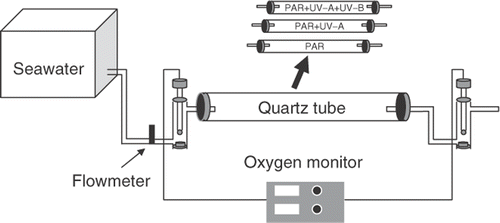
Fig. 2. Diurnal photosynthetic O2 evolution of Gracilaria lemaneiformis thalli exposed to PAR alone (P), PAR+UV-A (PA) and PAR+UVR (PAB) associated with solar radiations (PAR, UV-A and UV-B) on March 16 (A), March 21 (B), April 20 (C), May 23 (E) and May 28 (F), 2004, and on September 29, 2006 (D, under controlled temperature at 21.5–22.5°C and reduced solar radiation) to simulate the cloudy day, April 24, 2004. The temperature of the flowing-through seawater ranged 16–18°C on March 16, 17–19°C on March 21, 21–23°C on April 20, 26–28°C on May 23, 26–28°C on May 28.
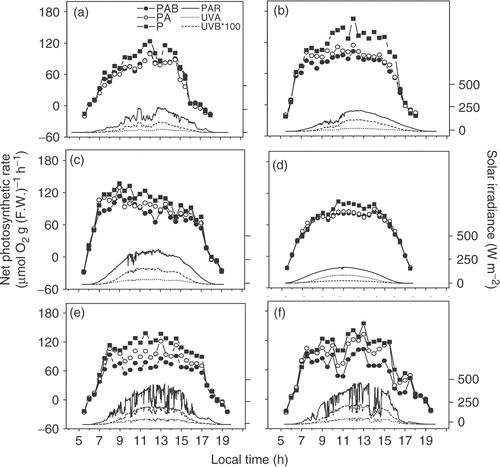
Fig. 3. Diurnal photosynthetic O2 evolution under PAR+UVR (280–700nm) and PAR+UV-A (320–700nm) as compared with PAR (400–700nm) in relation to mean solar irradiance (PAR), on cloudy (A) and sunny days (B).
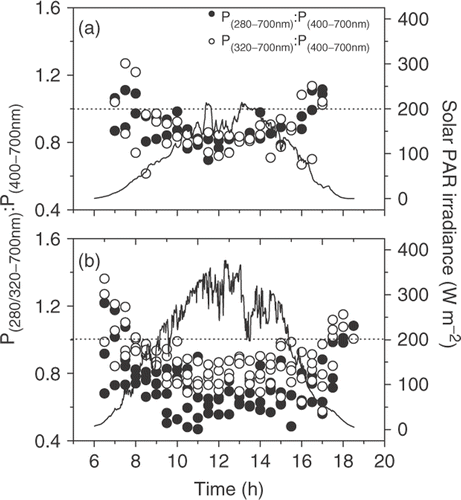
Fig. 4. Net photosynthetic rate of Gracilaria lemaneiformis as a function of irradiance in the morning (black symbols) and afternoon (white symbols) under different radiation treatments on March 16 (A), March 21 (B), April 20 (C), May 23 (E) and May 28 (F), 2004, and on September 29, 2006 (D, temperature controlled at 21.5–22.5°C and solar radiation reduced) to simulate the cloudy day, April 24, 2004.
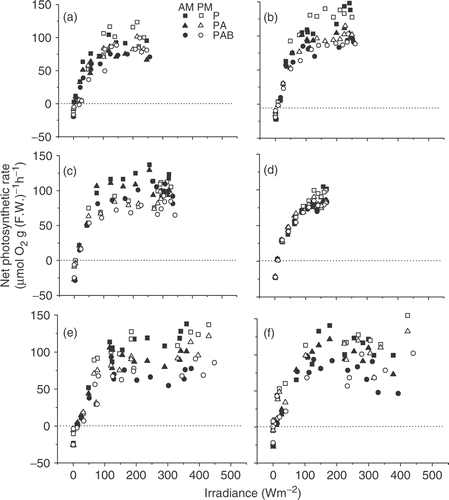
Fig. 5. UVR-induced photosynthetic inhibition (from early morning to late afternoon) in relation to UVR irradiance in March, April (including September 29, 2006, simulated conditions for the cloudy day, April 24, 2004) and May, 2004. The lines represent a linear fit of the data (p<0.001).
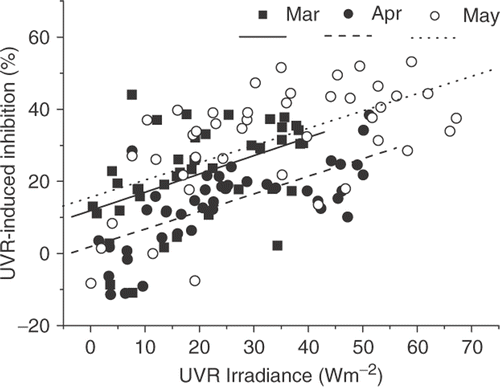
Fig. 6. Daily net photosynthetic production of Gracilaria lemaneiformis when exposed to PAR alone (P), PAR+UV-A (PA) and PAR+UVR (PAB) as a function of daily solar PAR dose in March, April (including September 29, 2006, simulated conditions for the cloudy day, April 24, 2004) and May, 2004. The daily net production was based on the integrated daytime photosynthesis shown in . R 2 values were 0.61, 0.77 and 0.31 for PAR alone (P), PAR+UV-A (PA) and PAR+UVR (PAB), respectively.
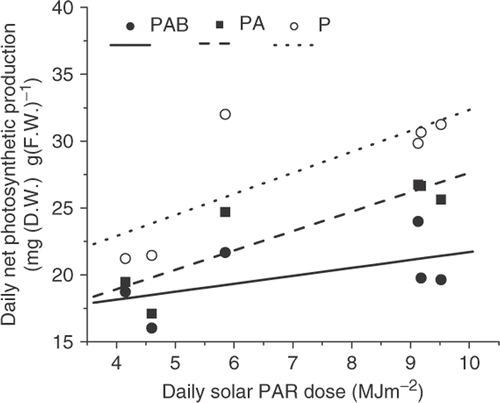
Fig. 7. Change in fresh mass (A,B) of Gracilaria lemaneiformis thalli under different solar radiation treatments (PAR alone [P], PAR+UV-A [PA] and PAR+UVR [PAB]) with time and changes of PAR, UV-A and UV-B from April 9–17 (A) or from May 12–20 (B). The corresponding relative growth rates were compared among the treatments in the two months (C). Vertical bars represent±SD of the means (three individuals in each of three tubes). Different letters show significant (p<0.05) differences among the treatments.
![Fig. 7. Change in fresh mass (A,B) of Gracilaria lemaneiformis thalli under different solar radiation treatments (PAR alone [P], PAR+UV-A [PA] and PAR+UVR [PAB]) with time and changes of PAR, UV-A and UV-B from April 9–17 (A) or from May 12–20 (B). The corresponding relative growth rates were compared among the treatments in the two months (C). Vertical bars represent±SD of the means (three individuals in each of three tubes). Different letters show significant (p<0.05) differences among the treatments.](/cms/asset/b717c5a1-c031-4eb8-9103-541a2ed95f73/tejp_a_298849_o_f0007g.gif)
Fig. 8. Absorption spectra for April (A) and May (B), UVAC (C), Chl a content (D) and UVAC:Chl a ratio (E) of Gracilaria lemaneiformis thalli after exposed to the radiation treatments (PAR alone [P], PAR+UV-A [PA] and PAR+UVR [PAB]) in April and May for 9 days, respectively. Different letters show significant (p<0.05) differences among the treatments.
![Fig. 8. Absorption spectra for April (A) and May (B), UVAC (C), Chl a content (D) and UVAC:Chl a ratio (E) of Gracilaria lemaneiformis thalli after exposed to the radiation treatments (PAR alone [P], PAR+UV-A [PA] and PAR+UVR [PAB]) in April and May for 9 days, respectively. Different letters show significant (p<0.05) differences among the treatments.](/cms/asset/75cdc7b7-8c76-4dc4-8c09-80c1066a29a0/tejp_a_298849_o_f0008g.gif)